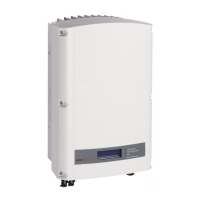Appendix A: Errors and Troubleshooting
SolarEdge Installation Guide – MAN-01-00057-2.2
The monitoring
hardware that checks
the balance of each
phase (L1-N and L2-N)
has exceeded allowed
limit.
Check the grid connection.
Check the GND wire connection.
Check the L1, L2 and Neutral wire
connections.
Verify symmetric load between L1 and
L2.
Consult the local grid authority.
AC Voltage Too
High (Line 1/2/3)
Grid voltage is above
the limit permitted in
this country.
Verify that the inverter is set to the
correct country.
Turn OFF the inverters in the site and
verify AC grid voltage.
If the inverter is located far from the
connection point to the grid, use a
larger gauge AC wire.
Consult the grid operator.
If permitted by local authorities, use the
SolarEdge Configuration Tool to change
the settings.
Grid Voltage is below
the limit permitted in
this country.
Verify that the inverter is set to the
correct country.
Consult the grid operator.
If permitted by local authorities, use the
SolarEdge Configuration Tool to change
the settings.
AC Freq Too High
(Line 1/2/3)
Grid frequency is above
the limit permitted in
this country.
Handle this in the same manner as error 32.
AC Freq Too Low
(Line 1/2/3)
Grid frequency is below
the limit permitted in
this country.
Handle this in the same manner as error 32.
DC Injection
(Line 1/2/3)
DC feed detected on
the AC output.
If the fault persists, contact SolarEdge
support.
AC grid voltage is out of
range. The inverter has
shut off due to
islanding.
When AC voltage returns, the inverter
should restart after the reconnection time,
which depends on country grid connection
codes.
If the problem persists, consult with the grid
operator whether frequent AC disruptions
have occurred at the site.
If the fault persists, contact SolarEdge
support.
The inverter is not
configured to any
country.
Select the country, as described on page
33.

